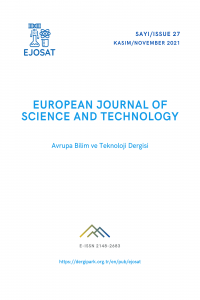Endoreversible Performance Analysis of a modified dual cycle and comparison with the classical engine cycles
Abstract
In this study, energetic performance analysis of an endoreversible modified dual cycle is performed. In this context, the net work and thermal efficiency of the modified cycle, are formulated with respect to certain basic design parameters. Also, conditions for maximum net work are investigated, and for the modified and classical cycles, compression ratio that maximizes the net work are analytically obtained with respect to extreme temperature ratio, isothermal expansion ratio, and cutoff ratio. The results of the performance analysis of the modified dual cycle are compared with those of classical engine cycles (otto, diesel and dual cycles). In terms of net work or power, modified cycle is demonstrated to be considerably more advantegous than the classical cycles. In terms of thermal efficiency, modified cycle performs better than dual and diesel cycle, but falls short slightly of the otto cycle.
References
- Klein SA. An explanation for observed compression ratios in internal combustion engines. J Engng Gas Turbines Power 1991;113:511–3.
- Blank DA, Wu C. The effect of combustion on a power optimized endoreversible Diesel cycle. Energy Convers Mgmt 1993;3(6):493–8.
- Orlov VN, Berry RS. Power and efficiency limits for internal combustion engines via methods of finite-time thermodynamics. J Appl Phys 1993;7(10):4317–22.
- Aragon-Gonzalez G, Canales-Palma A, Leon-Galicia A. Maximum irreversible work and efficiency in power cycles. J Phys D: Appl Phys 2000;33:1403–9.
- Leff HS. Thermal efficiency at maximum work output: New results for old heat engines. Am J Phys 1987;55(7): 602–10.
- Chen L, Lin J, Sun F, Wu C. Efficiency of an Atkinson engine at maximum power density. Energy Convers Mgmt 1998; 3(3/4):337–41.
- Lin J, Chen L, Wu C, Sun F. Finite-time thermodynamic performance of a dual cycle. Int J Energy Res 1999;2(9): 765–72.
- Al-Sarkhi, A., Jaber, J.O., Probert, S.D., 2006. Efficiency of a Miller engine. Appl Energ, 83,pp.343–351.
- Al-Sarkhi, A., Al-Hinti, I., Abu-Nada, E., Akash, B., 2007. Performance evaluation of irreversible Miller engine under various specific heat models. Int Commun Heat Mass, 34, pp.897–906.
- Rinaldini, C.A., Mattarelli, E., & Golovitchev, V.I., 2013. Potential of the Miller cycle on a HSDI diesel automotive engine. Applied Energy,112, pp.102-19.
- Gonca G, Sahin B. Performance investigation and evaluation of an engine operating on a modified dual cycle. International Journal of Energy Research. (In press.)
- Gupta H.N., 2009. Fundamentals of Internal Combustion Engines.1st Edition. PHI Learning Private Limited, New Delhi.
Endoreversible Performance Analysis of a modified dual cycle and comparison with the classical engine cycles
Abstract
In this study, energetic performance analysis of an endoreversible modified dual cycle is performed. In this context, the net work and thermal efficiency of the modified cycle, are formulated with respect to certain basic design parameters. Also, conditions for maximum net work are investigated, and for the modified and classical cycles, compression ratio that maximizes the net work are analytically obtained with respect to extreme temperature ratio, isothermal expansion ratio, and cutoff ratio. The results of the performance analysis of the modified dual cycle are compared with those of classical engine cycles (otto, diesel and dual cycles). In terms of net work or power, modified cycle is demonstrated to be considerably more advantegous than the classical cycles. In terms of thermal efficiency, modified cycle performs better than dual and diesel cycle, but falls short slightly of the otto cycle.
References
- Klein SA. An explanation for observed compression ratios in internal combustion engines. J Engng Gas Turbines Power 1991;113:511–3.
- Blank DA, Wu C. The effect of combustion on a power optimized endoreversible Diesel cycle. Energy Convers Mgmt 1993;3(6):493–8.
- Orlov VN, Berry RS. Power and efficiency limits for internal combustion engines via methods of finite-time thermodynamics. J Appl Phys 1993;7(10):4317–22.
- Aragon-Gonzalez G, Canales-Palma A, Leon-Galicia A. Maximum irreversible work and efficiency in power cycles. J Phys D: Appl Phys 2000;33:1403–9.
- Leff HS. Thermal efficiency at maximum work output: New results for old heat engines. Am J Phys 1987;55(7): 602–10.
- Chen L, Lin J, Sun F, Wu C. Efficiency of an Atkinson engine at maximum power density. Energy Convers Mgmt 1998; 3(3/4):337–41.
- Lin J, Chen L, Wu C, Sun F. Finite-time thermodynamic performance of a dual cycle. Int J Energy Res 1999;2(9): 765–72.
- Al-Sarkhi, A., Jaber, J.O., Probert, S.D., 2006. Efficiency of a Miller engine. Appl Energ, 83,pp.343–351.
- Al-Sarkhi, A., Al-Hinti, I., Abu-Nada, E., Akash, B., 2007. Performance evaluation of irreversible Miller engine under various specific heat models. Int Commun Heat Mass, 34, pp.897–906.
- Rinaldini, C.A., Mattarelli, E., & Golovitchev, V.I., 2013. Potential of the Miller cycle on a HSDI diesel automotive engine. Applied Energy,112, pp.102-19.
- Gonca G, Sahin B. Performance investigation and evaluation of an engine operating on a modified dual cycle. International Journal of Energy Research. (In press.)
- Gupta H.N., 2009. Fundamentals of Internal Combustion Engines.1st Edition. PHI Learning Private Limited, New Delhi.
Details
| Primary Language | English |
|---|---|
| Subjects | Engineering |
| Journal Section | Articles |
| Authors | |
| Early Pub Date | July 29, 2021 |
| Publication Date | November 30, 2021 |
| Published in Issue | Year 2021 Issue: 27 |


